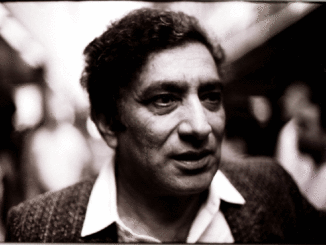
Ghalib’s poetic ascendancy: from nothingness to existence of meaning
by, Meraj Rana
Poetry is predicated on the utterance of inner moxie rather than extraneous motifs. Perhaps this is the pretense why pretty much all the great and important poets of the poetic tradition of Ghazal seem to inhabit a distinctive world of inner experience. Imdad Imam Asar wrote:
” Internal poetry is very tectonic for Ghazal. In my erudition, it is undoable to bring off the intents of the Ghazal with extrinsic poetry.”
Leverage has jagged to the importance of inner experience in poetry, but he has not persuaded this poetic point. However, his point is arguable.
Ghalib’s poetry is no remonstrance to this ascribe. But the inner world of Ghalib is very divergent from the inner world of Mir and other poets. Shamsur Rahman Faruqi admits that:
Ghalib’s ideation was heavenly and subtle, Mir’s imagination was terrestrial and unrestricted. Ghalib concocted a language for his poetry that can be called a “literary language.”
This opinion of Shamsur Rahman Faruqi is allied to Ghalib’s “Mirism”. It cannot be inconclusive, but when he says that Ghalib moonstruck very few of Mir’s subjects (which is quite true), then his first opinion becomes jumbled in its own incongruity. After the comparison of Mir and Ghalib, the inference reached by Shamsur Rahman Faruqi is commendable and worth following. He has built the foundation of Mir’s poetic preeminence on his vibrant life and not on his poetic deliberation.
This opinion of Shamsur Rahman Faruqi is utterly veracious and alluring. An intelligent poet like Ghalib could not have been anticipated to use earlier poetic subjects simply to establish his intellectual linkage with earlier poets. It is not that Ghalib’s poetry has not used the poetic subjects of his earlier Urdu and Persian poetry, but wherever he has used these subjects he has spawned completely new meanings in them. A couplet by Ghani Kashmiri (1630-1669):
بود گویا طفلِ نو رفتار شعرِ تازہ ام
کز لبم تا رفت بیرون بر زبان اوفتاد ہا
(My pristine couplet was like a new walking baby. But as soon as my couplet left my lips, it fell on (others’) tongues. It means that people remembered that couplet.) Ghalib’s astonishing expression on the same subject can be seen in his couplet:
آتے ہیں غیب سے یہ مضامیں خیال میں
غالب صریر خامہ نوائے سروش ہے
(My poetic subjects come to my mind from the unseen world. Ghalib is the only one writing the angel’s sound.)
This couplet is generally illustrated as a couplet of self-praise, ignoring its many merits. While the truth is that Ghalib here inspires self and others to unfasten the clump of his creative process. It means that Ghalib in this couplet describes his acts as having more impetus than imagination.
Obviously, due to the ingenious nature of the formulation, his vein has become revelatory. Then, with the exception of ‘sound of angel’ and ‘sound of pen’ many types of figures are also created. Ghani Kashmiri’s rendition of simile here has become so conspicuous that the end of the couplet was possible only on popularity. This means that his couplet was almost certain to become famous. Ghalib apparently does not draw any final inference like Ghani Kashmiri, but by mentioning the word ‘unseen’, he gives his poetic thought the status of a metaphysical musing very whimsically and considers himself to be the rep of spirituality in secret. Maulana Rumi’s couplet is:
سینہ خواہم شرحہ شرحہ از فراق
تا بگویم شرحِ دردِ اشتیاق
(I wish for my chest that it crumbles from separation so that I can express the sorrow of my longing. It means that the pain becomes so intense that it cannot be expressed).
Ghalib’s astonishing expression on the same subject can be seen in his couplet:
میری قسمت میں غم گر اتنا تھا
دل بھی یا رب کئی دیے ہوتے
Maulana Rumi has made the intensity of pain and its expression oneness by establishing the appropriation of ‘separation’. Whereas Ghalib, by simply describing the status of ‘anguish’, has disseminated the intenseness of the pain so much that it seems impossible to contain it. And the testimony of this is found in the second line of the couplet from the word ‘many hearts’. Secondly, the nature of agony is not defined here. Therefore, the scope of this grief seems to be as broad as the universe.
Ghalib is the only poet in the Urdu poetic tradition who does not see the world as it is. Therefore, his stance of rejecting a fact rather than accepting it.
When we say that the inner world of Ghalib is very different from the inner worlds of the poets before and after him, then this certainly raises the question whether Ghalib is not a poet of the tradition, which has been followed by Wali, Siraj, Mir, Sauda, Dard, Naseer and Zauq?
Obviously, this question cannot be answered in the affirmative. This means that Ghalib is a part of that tradition, but he does not accept that tradition like Mir and other poets, but Ghalib intentionally diverges from that tradition, as a result of which he has a kind of poetic tradition here. It seems ineluctable to mention here that Ghalib has acquired as much benefit from the poetic tradition as he considered it necessary.
This need was only so that he could substantiate his unheard-of experience in the literary tradition of Delhi to be familiar in the literary society of Delhi. That is why he does not see the observance of tradition, which is equally seen here by all the poets from Wali to Mir and from Mir to Ahmad Mushtaque. To understand this with reference to an example, the following couplets can be seen:
عاشقاں کو شہید کر کے صنم
کف حنائی نہ کر خدا سوں ڈر
(ولی)
ذوق اس پائے نگاریں کا جو ہے وصف نگار
اشکِ خونیں سے ہے کاغذ کو حنائی کرتا
(ذوق)
مشہدِ عاشق سے کوسوں تک جو اگتی ہے حنا
کس قدر یا رب ہلاکِ حسرتِ پا بوس تھا
(غالب)
In all these couplets, “henna” is a key word used to describe the inner condition of the poetic savvy. When we read these three couplets, the process of creating meaning through the word “henna” seems to be almost the same. In the chronological order of the above couplets, only Ghalib’s couplet creates a sense of estrangement based on his intricate internal experience. Ghalib’s did not affix himself to any other aspect of the tradition except the use of the word “henna” in the name of the tradition. Therefore, unlike Zauq and Wali, in his couplet, “henna” is not finite to a basic word, but becomes a metaphor through which we get hold of the progression of experience.
In the couplets of both Wali and Zauq, the attribute of “henna” is described in such a way that it takes on a poetic colour. This means that the situation of the lover has been accentuated here by the adjective of “henna”. The only difference between the two couplets is that in the case of Wali, henna’s attribute is made up of melancholy tones and in the case of Zauq, it is composed of jovial tones. And it occurred because both of them saw the same quality of “henna” that it seems.
Therefore, there is no other quality in both the couplets except the sound fascination . Still, to some extent, Wali has reached the pretext of the poetic meaning of “hand” by finding a common value between “henna” and “blood”, while Zauq, despite his word composition, has made his couplet beyond a conceptual statement. Not only this, but Zauq made the awfulness of “bloody tear” so conspicuous that henna’s other attributes have almost vanished. And therefore, a kind of embellished artifice arose in a couplet.
Ghalib’s couplet is not only unusual in terms of thought and expression, but also a manifestation of deflection from the prevalent poetic tradition.
In the first line, there are three basic words, ‘mashhad’(a place to slay ), ‘ashiq’ (lover) and henna, while the key words of the second line are ‘halak'(death) and ‘gasrat-e-pabos (desire to kiss the feet), whose dialectical disposition establishes the narrative of the first line.
This means that the crop of henna grown far away is not natural, but the actual reason for its maturation is the death of the lover. It means that after the lover’s martyrdom, the henna crop has grown in the area around the killing site as far as the persuasiveness of his blood has reached.
The best point of Ghalib’s couplet is hidden in the word ‘mashhad’ (a place to slay). If he wrote this line in such a way that “henna grows far away from the place where the lover is killed”, the couplet would not have the richness of meaning that could have been created by his original line.
We know that the common concept of ‘maqtal’ (a place of murder) is associated with unnatural death. Here the deceased can be a normal person or a special one, the deceased can be a good person or a bad person. While ‘mashhad’ (a place to slay) refers to the place where someone is martyred. Martyrdom is a sacred act and has a rich Islamic history. In the Qur’an, Allah says that he “gives life to the martyrs, they are provided with sustenance.” Ghalib has not just used ‘mashhad’ (a place to slay) but has used the syntax of ‘mashhad-e-aashiq’ (a place to kill the lover).
Martyrdom has also been defined as the one who dies or is killed in pursuit of a good cause will be called a martyr. It means that the martyred person will be called alive even after death. The first meaning from the study of the couplet is that the lover’s love for his beloved was impeccable. Therefore, his death is not an ordinary death but martyrdom. The other meaning is that the lover is not dead but alive.
The third meaning is that after his murder, the repercussions of his blood made it possible for henna to grow. This means that the attribute of redness in henna arose because of his blood. The facticity is that redness in henna is a natural and botanical process, but as stated in the beginning, Ghalib does not see worldly things as they appear. Therefore, here the unnatural attribute of henna (lover’s blood) has been described with some creativity that it has become its original and natural attribute (redness).
There is also a subtle meaning in this couplet that the lover died in the desire to kiss the beloved’s feet.
And since the beloved’s feet are also related to henna, the desire of the lover here becomes the cause of the crop of henna. There is also a hidden meaning in the couplet of the lover’s trampling in connection with kissing the feet. That is, the dialectical situation illuminated in the cited couplet is only related to a lover. If the same thing is said briefly, it can be said that Ghalib here seems to be imposedl ike time on the excellence of his inner world.




